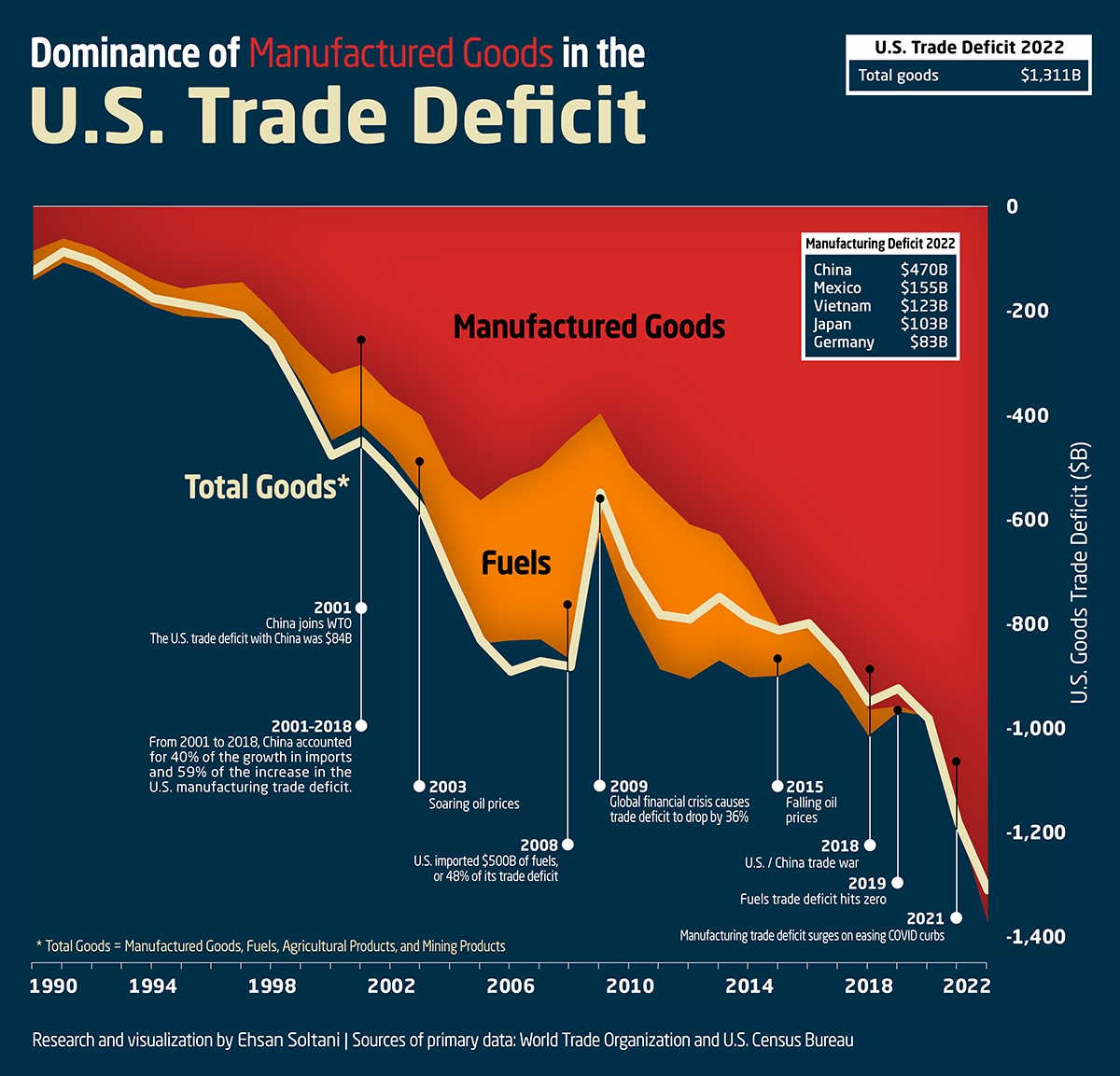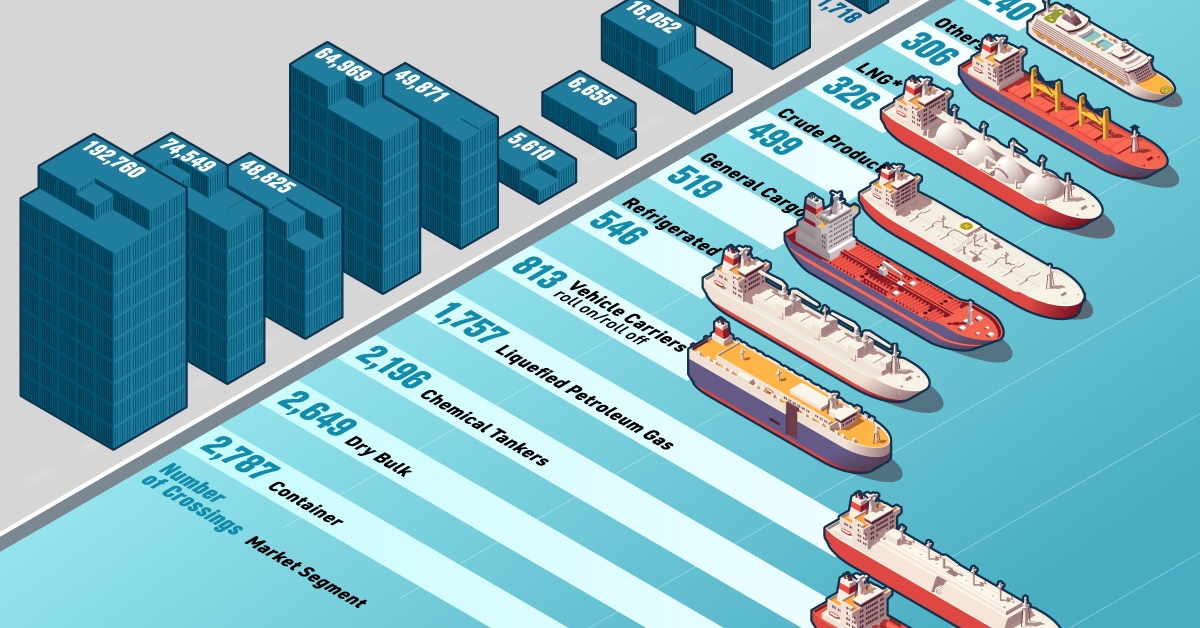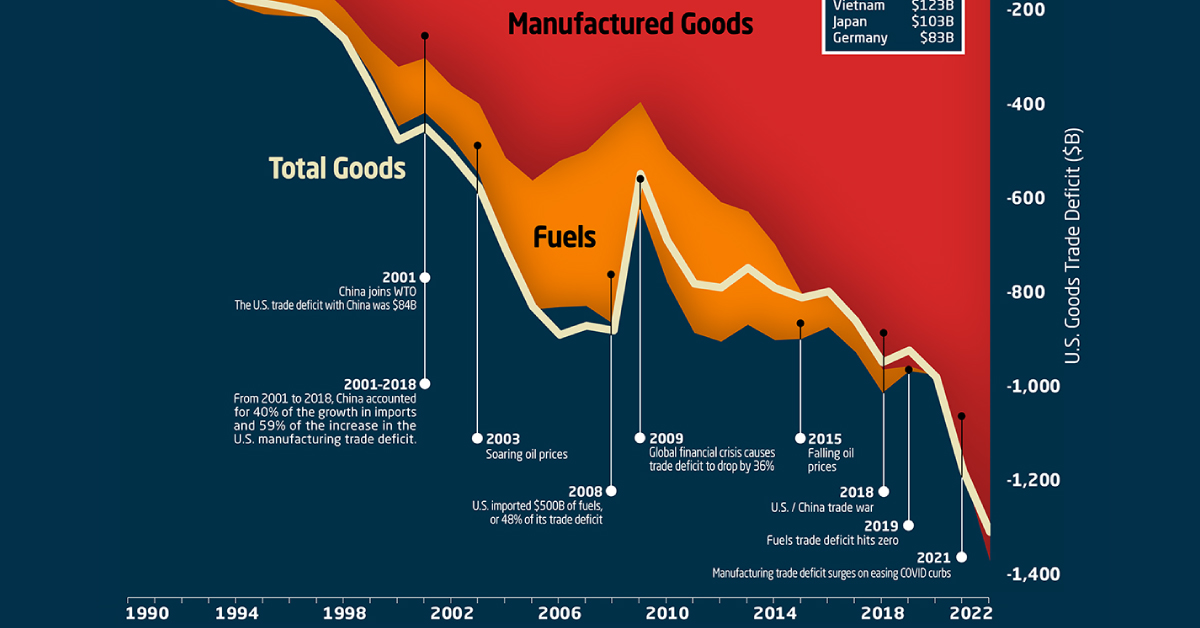Commodities
Charted: What’s Driving the U.S. Trade Deficit?

How Manufactured Goods Dominate the U.S. Trade Deficit
The United States has had many major trading partners over the decades, with annual imports and exports from them both totaling trillions of dollars.
Ever since the 1970s, the country’s imports started to overshadow exports and the U.S. trade deficit began to grow. Once the 1990s began, fueled by globalization-friendly policies around the world and cheap international goods, the trade deficit began to climb even more rapidly.
In this graphic, Ehsan Soltani uses data from the World Trade Organization to highlight the role of manufactured goods in the rising U.S. trade deficit over the last three decades.
U.S. Trade Deficit in Goods From 1990 to 2022
In 2022, the U.S. trade deficit for goods hit $1.31 trillion, consisting of more than $3 trillion in imports and offset by $2 trillion in exports. That’s a growth of 40% over a decade from a deficit $791 billion in 2012.
| Year | U.S. Exports (Total) | U.S. Imports (Total) | Trade Surplus/Deficit |
|---|---|---|---|
| 2022 | $2,065B | $3,376B | -$1,311B |
| 2021 | $1,754B | $2,935B | -$1,183B |
| 2020 | $1,425B | $2,407B | -$982B |
| 2019 | $1,643B | $2,567B | -$924B |
| 2018 | $1,664B | $2,614B | -$950B |
| 2017 | $1,546B | $2,408B | -$862B |
| 2016 | $1,451B | $2,250B | -$799B |
| 2015 | $1,503B | $2,315B | -$813B |
| 2014 | $1,621B | $2,413B | -$792B |
| 2013 | $1,580B | $2,329B | -$749B |
| 2012 | $1,546B | $2,337B | -$791B |
| 2011 | $1,483B | $2,266B | -$784B |
| 2010 | $1,278B | $1,969B | -$691B |
| 2009 | $1,056B | $1,605B | -$549B |
| 2008 | $1,287B | $2,169B | -$882B |
| 2007 | $1,148B | $2,020B | -$872B |
| 2006 | $1,026B | $1,918B | -$892B |
| 2005 | $901B | $1,733B | -$832B |
| 2004 | $815B | $1,526B | -$711B |
| 2003 | $725B | $1,303B | -$578B |
| 2002 | $693B | $1,200B | -$507B |
| 2001 | $729B | $1,179B | -$450B |
| 2000 | $782B | $1,259B | -$477B |
| 1999 | $696B | $1,059B | -$364B |
| 1998 | $682B | $944B | -$262B |
| 1997 | $689B | $899B | -$210B |
| 1996 | $625B | $822B | -$197B |
| 1995 | $585B | $771B | -$186B |
| 1994 | $513B | $689B | -$177B |
| 1993 | $465B | $603B | -$139B |
| 1992 | $448B | $554B | -$106B |
| 1991 | $422B | $508B | -$87B |
| 1990 | $394B | $517B | -$123B |
When compared to trade numbers from the early 1990s and 2000s, its clear how much U.S. trade as a whole has grown.
In 1992, the U.S. trade deficit for goods sat at only $106 billion, with imports totaling $554 billion and exports totaling $448 billion. Just a decade later by 2002, the deficit had already climbed by five times.
Manufactured Goods Trade Outshines Fuel
Analyzing the subtleties in the country’s deficit in traded goods also shows how U.S. reliance on other countries has changed over the years.
In 1990, the deficit incurred from trading manufactured goods—which doesn’t include fuel, mining production, agricultural products, or services—contributed to 69% of the total U.S. goods trade deficit.
| Year | U.S. Exports (Manufactured) | U.S. Imports (Manufactured) | Trade Surplus/Deficit |
|---|---|---|---|
| 2022 | $1,196B | $2,569B | -$1,372B |
| 2021 | $1,079B | $2,256B | -$1,177B |
| 2020 | $915B | $1,892B | -$976B |
| 2019 | $1,036B | $1,994B | -$958B |
| 2018 | $1,050B | $2,016B | -$966B |
| 2017 | $1,008B | $1,872B | -$864B |
| 2016 | $969B | $1,775B | -$806B |
| 2015 | $1,008B | $1,811B | -$803B |
| 2014 | $1,052B | $1,752B | -$700B |
| 2013 | $1,020B | $1,650B | -$629B |
| 2012 | $1,009B | $1,619B | -$610B |
| 2011 | $969B | $1,524B | -$555B |
| 2010 | $872B | $1,369B | -$497B |
| 2009 | $725B | $1,122B | -$397B |
| 2008 | $973B | $1,417B | -$443B |
| 2007 | $909B | $1,409B | -$500B |
| 2006 | $829B | $1,350B | -$522B |
| 2005 | $674B | $1,238B | -$564B |
| 2004 | $618B | $1,134B | -$516B |
| 2003 | $589B | $990B | -$401B |
| 2002 | $571B | $934B | -$363B |
| 2001 | $602B | $906B | -$303B |
| 2000 | $646B | $968B | -$322B |
| 1999 | $575B | $843B | -$268B |
| 1998 | $558B | $758B | -$199B |
| 1997 | $553B | $699B | -$145B |
| 1996 | $485B | $634B | -$150B |
| 1995 | $450B | $608B | -$158B |
| 1994 | $399B | $540B | -$141B |
| 1993 | $356B | $465B | -$109B |
| 1992 | $340B | $420B | -$79B |
| 1991 | $319B | $380B | -$61B |
| 1990 | $290B | $376B | -$85B |
Since then, despite the country exporting billions of dollars of products, the deficit caused by imported manufactured goods has only grown. In 2021, it crossed $1 trillion in deficit alone.
Part of that growth is directly tied to increasing imports from China over the 21st century. From 2001 to 2018, China’s exports to the U.S. accounted for 59% of the latter’s increasing manufacturing trade deficit, ranging in goods from electronics to machinery.

However, the U.S. managed to recover some of this deficit through surplus fuel exports, which have been increasing over the same time period.
| Year | Fuel Exports | Fuel Imports | Fuel Surplus/Deficit |
|---|---|---|---|
| 2022 | $378B | $323B | $56B |
| 2021 | $240B | $224B | $16B |
| 2020 | $155B | $130B | $25B |
| 2019 | $200B | $210B | $-10B |
| 2018 | $193B | $242B | $-49B |
| 2017 | $139B | $204B | $-65B |
| 2016 | $94B | $163B | $-69B |
| 2015 | $104B | $200B | $-96B |
| 2014 | $155B | $358B | $-203B |
| 2013 | $149B | $389B | $-240B |
| 2012 | $137B | $433B | $-295B |
| 2011 | $130B | $463B | $-332B |
| 2010 | $81B | $364B | $-283B |
| 2009 | $55B | $279B | $-224B |
| 2008 | $77B | $502B | $-425B |
| 2007 | $42B | $372B | $-330B |
| 2006 | $35B | $345B | $-310B |
| 2005 | $27B | $301B | $-275B |
| 2004 | $19B | $217B | $-198B |
| 2003 | $14B | $163B | $-149B |
| 2002 | $12B | $122B | $-110B |
| 2001 | $13B | $129B | $-116B |
| 2000 | $13B | $140B | $-126B |
| 1999 | $10B | $79B | $-69B |
| 1998 | $10B | $62B | $-52B |
| 1997 | $13B | $83B | $-70B |
| 1996 | $12B | $77B | $-65B |
| 1995 | $10B | $63B | $-53B |
| 1994 | $9B | $60B | $-51B |
| 1993 | $10B | $59B | $-49B |
| 1992 | $11B | $59B | $-47B |
| 1991 | $12B | $58B | $-46B |
| 1990 | $12B | $69B | $-56B |
Historically the U.S. was a larger fuel consumer than producer, and was heavily affected by soaring oil prices from 2003 to the Great Recession. In 2008, the United States trade deficit in fuel hit $425 billion.
But a boom in shale oil production has seen the country rapidly increase production and exports, becoming the world’s largest crude oil producer. Despite falling oil prices, by 2020 the U.S. managed to erase its fuel trade deficit.
Will The U.S. Trade Deficit Keep Growing?
The dominance of manufactured goods in the U.S. trade deficit poses a significant challenge for policymakers and businesses.
On one hand, the country’s reliance on other countries for cheaper parts and labor has allowed its economy to benefit. But it has also become increasingly susceptible to tariffs, slowdowns in other countries, and trade wars.
While there are efforts in place to promote domestic manufacturing, such as in semiconductor chips, the effects have yet to dent the goods trade deficit.

This article was published as a part of Visual Capitalist's Creator Program, which features data-driven visuals from some of our favorite Creators around the world.
Markets
Panama Canal Traffic by Shipment Category and Tonnage
This graphic illustrates Panama Canal traffic by shipment category, looking at the total number of shipping crossings and the total tonnage.

Panama Canal Traffic by Shipment Category and Tonnage
This was originally posted on our Voronoi app. Download the app for free on iOS or Android and discover incredible data-driven charts from a variety of trusted sources.
Daily Panama Canal traffic has been steadily restricted to start the year, with an expected peak reduction of over 40% by February 2024 due to severe drought. The problem is already affecting supply chains for U.S. and Asian importers.
This graphic illustrates the number of shipping crossings by market segment at the Canal and the net tonnage carried during the Annual Fiscal 2023 (October 2022 to September 2023). Data is from the Panama Canal Authority.
About the Panama Canal
The Panama Canal is an artificial 82-kilometer (51-mile) waterway that connects the Pacific Ocean with the Atlantic Ocean, built between 1904 and 1914.
The Canal locks at each end lift ships to Gatun Lake, an artificial freshwater lake 26 meters (85 ft) above sea level. The shortcut dramatically reduces the time for ships to travel between the two oceans, enabling them to avoid the route around the southernmost tip of South America via the Drake Passage or Strait of Magellan.
The Panama Canal moves roughly $270 billion worth of cargo annually–it’s the trade route taken by 40% of all U.S. container traffic alone and handles about 5% of all global maritime trade.
The Driest October in 70 Years
Last October, however, Panama received 41% less rainfall than usual, leading to the driest October in 70 years in what was supposed to be Panama’s rainy season, bringing the level of the Gatun Lake almost six feet below where it was a year ago. Additionally, infrastructure constraints led the Panama Canal Authority to restrict the number of ships that could pass each day.
The principal commodity groups carried through the Canal are motor vehicles, petroleum products, grains, coal, and coke.
| Market Segment | Transits (#) | Net Tonnage (thousands) |
|---|---|---|
| Container | 2,787 | 192,760 |
| Dy Bulk | 2,649 | 74,549 |
| Chemical Tankers | 2,196 | 48,825 |
| Liquefied Petroleum Gas | 1,757 | 64,969 |
| Vehicle Carriers | 813 | 49,871 |
| Refrigerated | 546 | 5,610 |
| General Cargo | 519 | 6,655 |
| Crude Product Tankers | 499 | 16,052 |
| Liquefied Natural Gas | 326 | 37,001 |
| Other | 306 | 1,718 |
| Passengers | 240 | 12,361 |
| Total | 12,638 | 510,370 |
According to the Panama Canal Authority, most of its traffic came from containers and dry bulk like soybeans. The world’s largest operator of chemical tankers (Stolt-Nielsen) typically also uses the Canal. However, due to the drought and the backup at the crossing, the operator has decided to reroute its fleet to the Suez Canal.
Although representing the smaller number of crossings, the Canal is also an important route for passengers, with many ocean cruise lines offering popular Panama Canal itineraries that sail through the Canal in the approximately 8-hour passage to their next destination in the opposite ocean.
-

 Science1 week ago
Science1 week agoVisualizing the Average Lifespans of Mammals
-

 Markets2 weeks ago
Markets2 weeks agoThe Top 10 States by Real GDP Growth in 2023
-

 Demographics2 weeks ago
Demographics2 weeks agoThe Smallest Gender Wage Gaps in OECD Countries
-

 United States2 weeks ago
United States2 weeks agoWhere U.S. Inflation Hit the Hardest in March 2024
-

 Green2 weeks ago
Green2 weeks agoTop Countries By Forest Growth Since 2001
-

 United States2 weeks ago
United States2 weeks agoRanked: The Largest U.S. Corporations by Number of Employees
-

 Maps2 weeks ago
Maps2 weeks agoThe Largest Earthquakes in the New York Area (1970-2024)
-

 Green2 weeks ago
Green2 weeks agoRanked: The Countries With the Most Air Pollution in 2023















